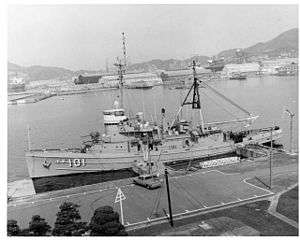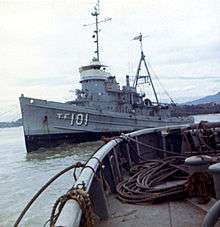USS Cocopa (ATF-101)
 USS Cocopa (ATF-101) at Sasebo, Japan, likely 1969 or 1972. | |
| History | |
|---|---|
| Name: | USS Cocopa |
| Builder: | Charleston Ship Building and Drydock Company, Charleston, SC |
| Launched: | 5 October 1943 |
| Sponsored by: | Miss Z. Williams |
| Commissioned: | 25 March 1944 |
| Decommissioned: | 30 September 1978 |
| Struck: | 30 September 1978 |
| Motto: | Service - Salvage - First and Finest |
| Honors and awards: |
|
| Fate: | Sold to Mexico, 30 September 1978 |
| Name: | ARM Seri (RE-03) |
| Acquired: | 30 September 1978 |
| Status: | In active service as of 2009 |
| General characteristics | |
| Class and type: | Abnaki class Fleet Ocean Tug |
| Displacement: | 1,240 long tons of standard displacement |
| Length: | 205 ft (62 m) |
| Beam: | 38.5 ft (11.7 m) |
| Draft: | 15.33 ft (4.67 m) |
| Propulsion: | Diesel-electric, single screw, 3,600shp |
| Speed: | 16.5 knots (30.6 km/h; 19.0 mph) |
| Complement: | 85 officers and men |
| Sensors and processing systems: | Radar |
| Armament: |
|
USS Cocopa (ATF-101) was an Abnaki class fleet ocean tug that served on active duty with the U.S. Navy from 1944 to 1978, seeing action in World War II, the Korean War and the Vietnam War. After thirty-four years of service, she was sold to the Mexican Navy, where she continues in service to this day (2009).[1]
World War II
Cocopa was named after an Arizona Indian tribe. She began her naval career with the Atlantic fleet during the waning months of World War II, making two passages across the Atlantic with barges in tow, followed by a third passage to Trinidad. Cocopa was next ordered to the Pacific theater, witnessing the final days of the war between July and August of that year. V-J day found the ship in Leyte, Philippines.[2]
Interwar service
Following World War II, Cocopa shuttled between the Philippines, Shanghai, Okinawa and Hong Kong on occupation duty, before returning to Puget Sound Naval Shipyard in January 1947 for an overhaul.
In June 1951, Cocopa accepted what some writers have termed the last Japanese surrender from World War II, when Lt. Cmdr. James B. Johnson accepted the capitulation of nineteen Japanese soldiers who had been living on the island of Anatahan, in the Northern Mariana Islands. The ship repatriated these men and their personal effects to Guam, from whence they were ultimately returned to Japan.[2] However, other Japanese holdouts continued to surrender over the next few decades, though in much smaller numbers.
Korean War
Returning to Pacific ocean service, The Cocopa saw action in the Korean War during the summer of 1953. During this period she served off both Korean coasts; in one operation, she towed the HMCS Huron, a Canadian destroyer that had run aground on the island of Pang Yang-Do, just off the North Korean coast well north of enemy-held Wonsan harbor. At the time of the armistice, she went to Wonsan to aid in the removal of a Marine garrison occupying a small islet at the harbor's mouth. During the Korean War, the USS Cocopa received one battle star for her service.[3]
Operation Castle
In March 1954, Cocopa was one of the ships tasked to support Operation Castle, a series of high-energy (high-yield) nuclear tests by Joint Task Force SEVEN (JTF-7) at Bikini Atoll. Official reports indicated that crewmembers suffered the highest doses (2.2 rem) of radiation endured by any of the navy ships present at this operation.[4]
Vietnam War

During the Vietnam War, Cocopa would see service in five campaigns: Advisory (1963), Vietnam Defense (1965), Counteroffensive Phase II (1967), Summer-Fall 1969, and Ceasefire (1972). In 1965, Cocopa hosted Detachment Charlie of Beach Jumpers Unit One, Team Twelve, operating as the "Yankee Station Special Surveillance Unit". This outfit consisted of one officer and five enlisted men, whose mission was to jam Soviet electronic intelligence trawlers monitoring U.S. operations in the Gulf of Tonkin. Team members utilized random wave jamming with noises (including bagpipe recordings) to counteract Russian SIGINT activities. Cocopa also assisted in towing, recovery and similar operations throughout her tours in Vietnam.[5]
Awards
Cocopa was awarded the appropriate service medals for World War II (including the American Campaign Medal, the European-African-Middle Eastern Campaign Medal and the Asiatic-Pacific Campaign Medal), Korea and Vietnam. She was also awarded a battle star for her Korean service, and five campaign stars for her Vietnam service. She was also granted the Navy Occupation Service Medal, the Armed Forces Expeditionary Medal, and the Republic of Korea War Service Medal.[3]
Mexican Navy service
On September 30, 1978, the Cocopa was decommissioned and sold to Mexico under the Security Assistance Program, where she was recommissioned in the Mexican Navy as the ARM Seri (RE-03). As of 2009 the ship remains on active duty with that force.[1]
References
- Notes
- 1 2 "The last surrender of World War II". CNMI. Retrieved 27 November 2009.
- 1 2 "Cocopa". Dictionary of American Naval Fighting Ships. Navy Department, Naval History & Heritage Command. 2015. Retrieved 14 February 2015.
- ↑ Charles Thomas; Jerald Goetz; Jeffrey Klemm; Edward Ortlieb (October 1991). "Analysis of Radiation Exposure for Additional Naval Personnel at Operation CASTLE-Supplemental Report" (PDF). Alexandria, Virginia: Defense Nuclear Agency. Retrieved 14 February 2015.
- ↑ "CUS Navy Beach Jumpers". Psywarrior.com. Retrieved 26 November 2009.
- Bibliography
- Task Force 77. Contains brief, detailed info on Cocopa's Korean War service.
- Official Damage Report of the Grounding of HMCS Huron. Describes role of the Cocopa (referred to in this report as "the tug") in towing the damaged Huron.
- This article incorporates text from the public domain Dictionary of American Naval Fighting Ships. The entry can be found here.
External links
- USS Cocopa. Offers several photos from the Cocopa's service, circa 1952-78.
- Last Defenders of the Japanese Empire. Photo of 19 Japanese soldiers on Anatahan surrendering to Lt. Cmdr. J.B. Johnson, captain of the Cocopa.
- My Journey to Vietnam, by Steven Karoly. Personal account by a Cocopa cook of a stormy voyage to Vietnam in 1972.
- Adventures of the Cocopa Personal photographs taken by the ship's electronic technician, 1973 to 1978.